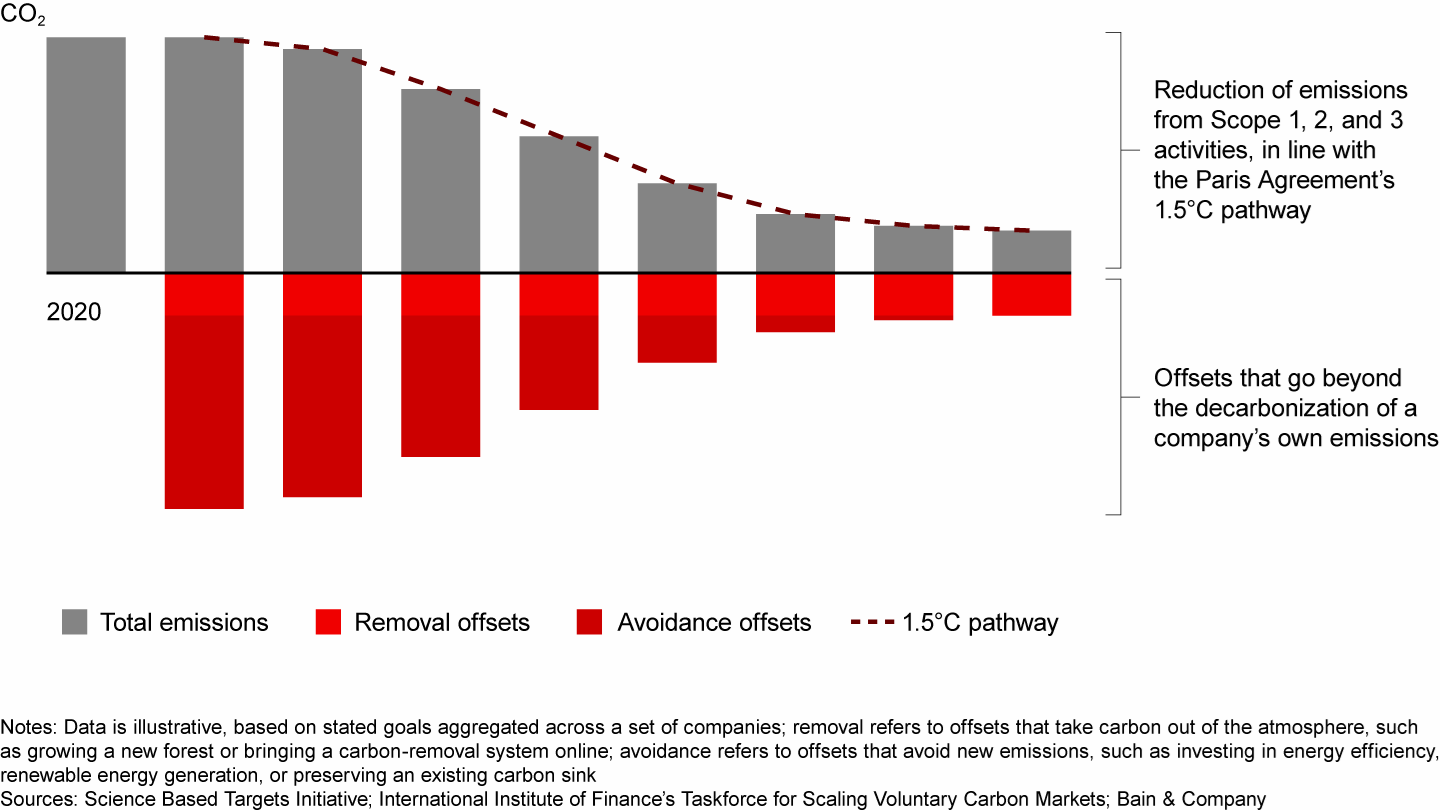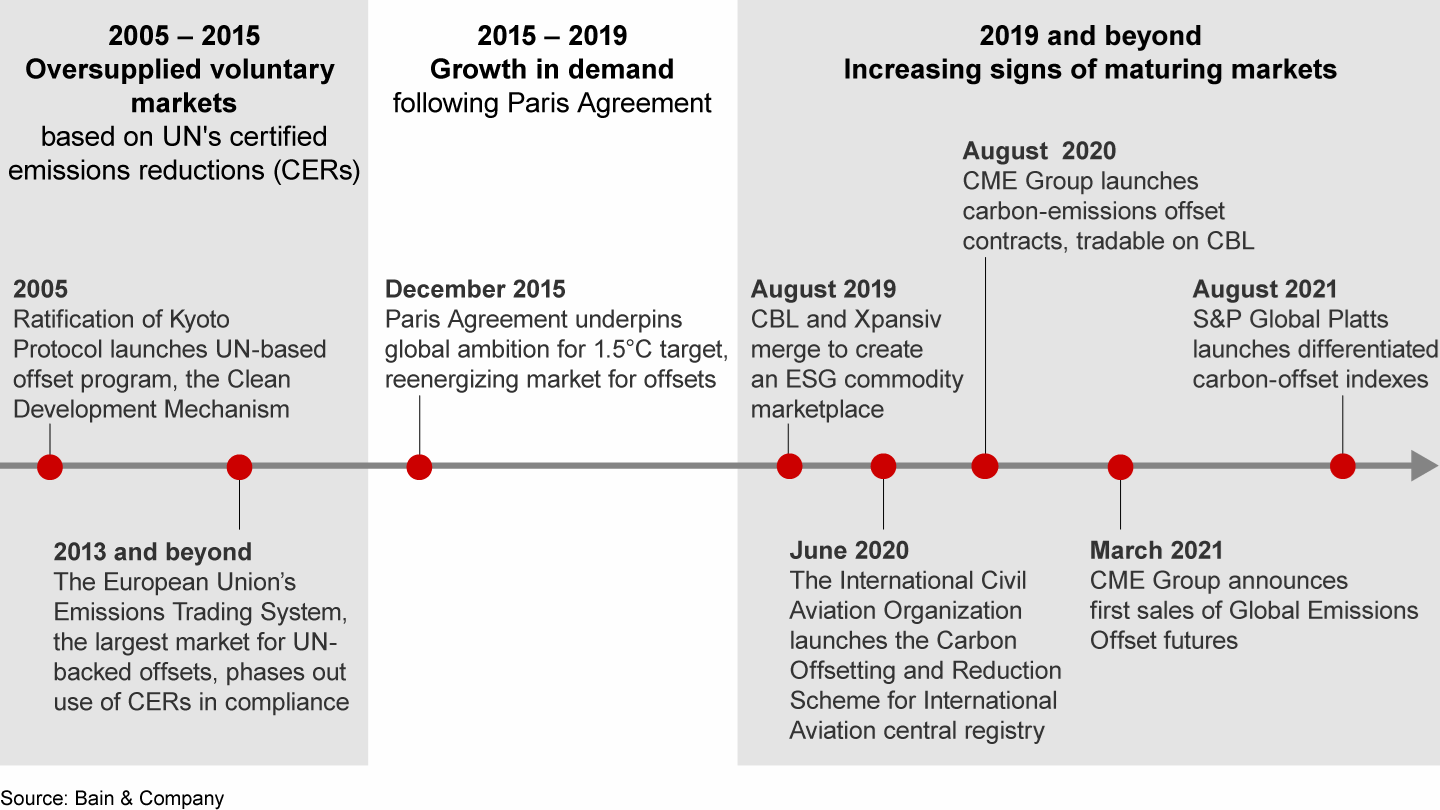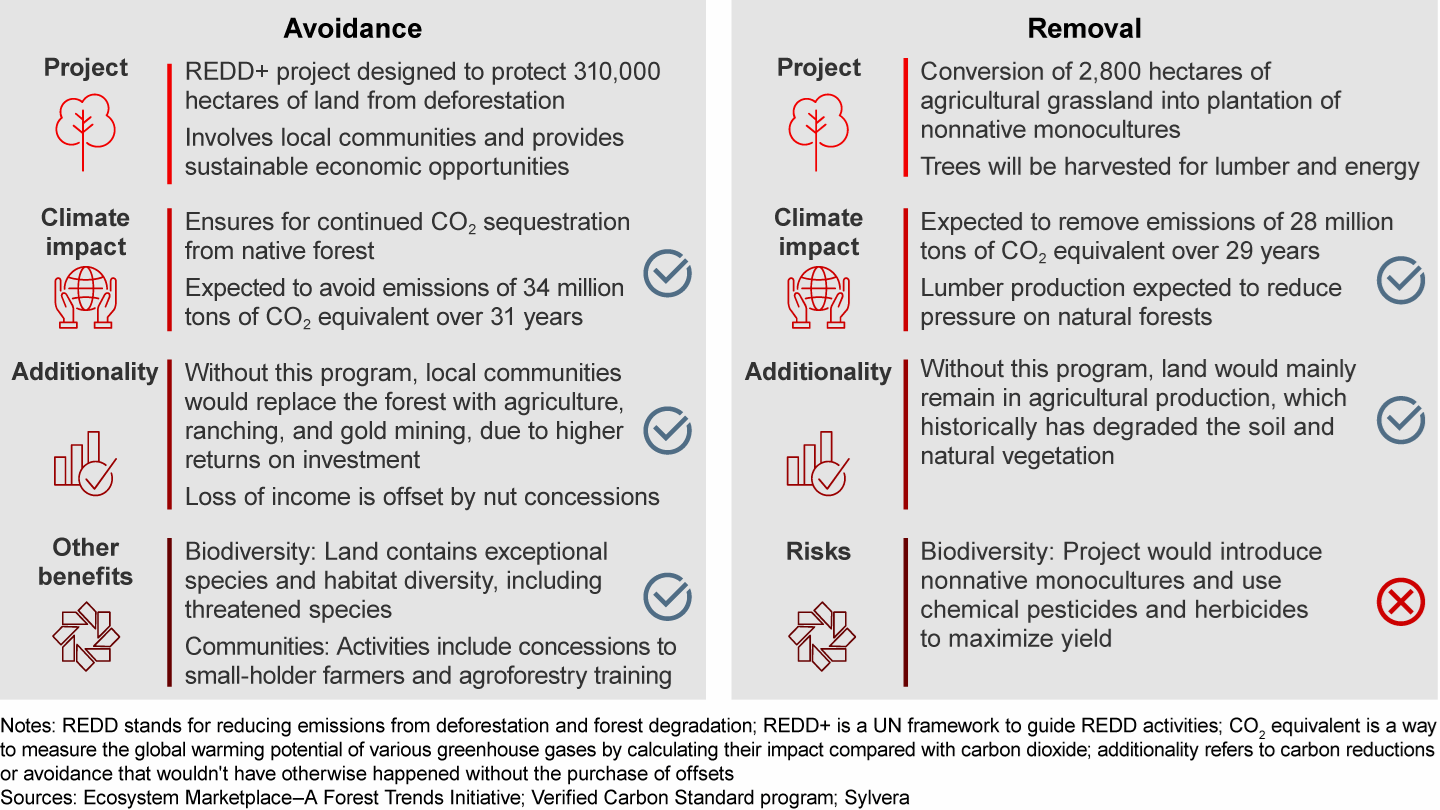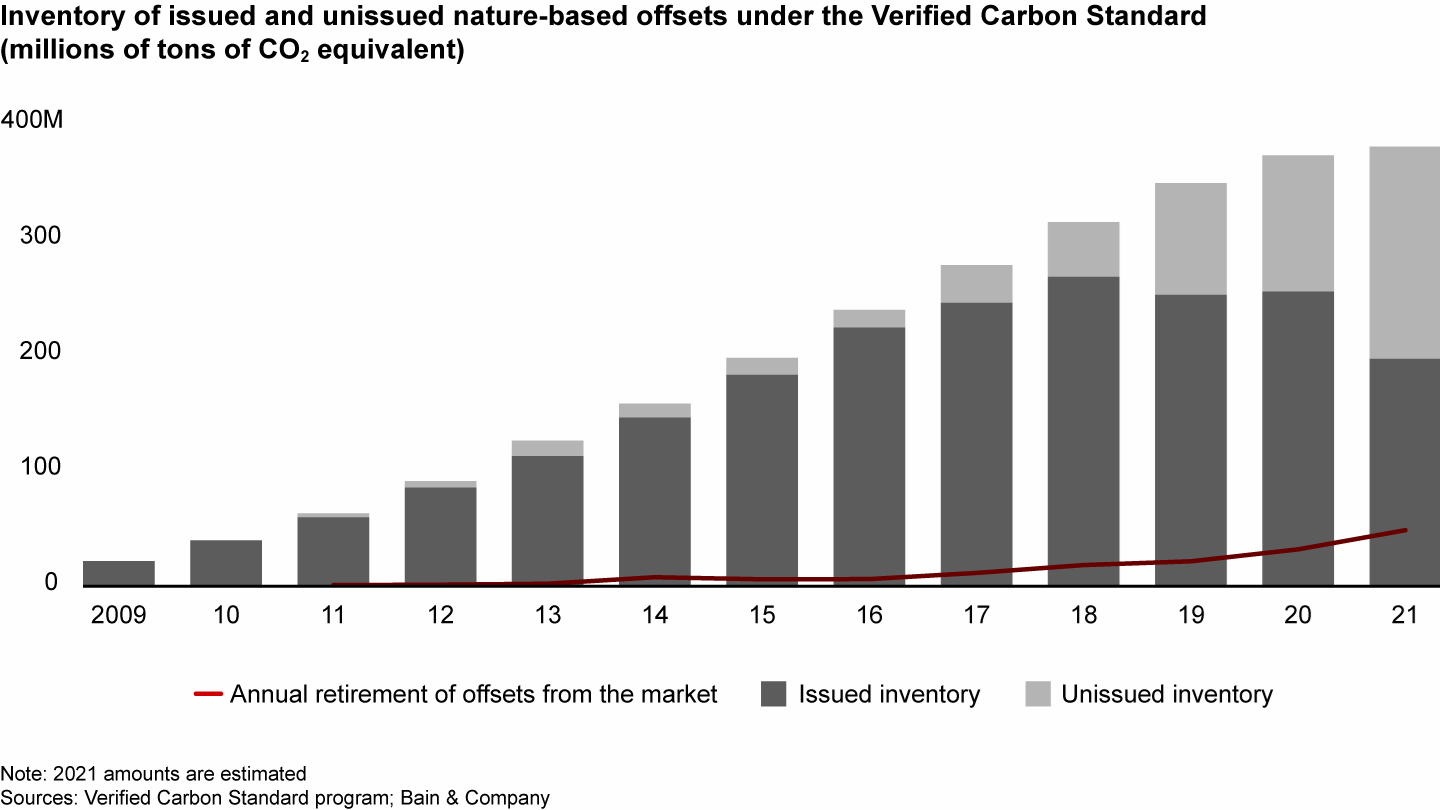論説

At a Glance
- Many companies will need to purchase carbon offsets to reach their ambitious goals of reducing their carbon emissions to net zero.
- The young carbon-offset market is inherently complicated, but beginning to mature with new market players developing more advanced exchanges and financial instruments.
- Demand for offsets is high and rising, against a tightening supply.
- As companies integrate offsets into their decarbonization strategies, they’ll need to develop better capabilities to source and analyze them.
Companies are setting ambitious decarbonization goals, but not all carbon emissions can be easily mitigated, given technological and economic limitations. To reach net-zero goals, many companies may need to purchase offsets, which allow them to balance their hard-to-abate emissions with investments that preserve or restore forests, wetlands, or other natural resources that either remove carbon dioxide from the atmosphere or prevent new emissions. Buying such offsets helps companies become carbon-neutral while they continue to work to reduce their greenhouse gas emissions. For example, a cement producer might invest in preserving large swaths of forest that may have been at risk of being cleared, to compensate for carbon emissions that it hasn't yet removed from its own manufacturing process or supply chain.
However, the carbon-offset markets are still in early development, and have been criticized for being difficult to navigate, hard to validate, and open to greenwashing accusations by activists. This has created some confusion about carbon offsets, which can prevent executives from getting a clear and objective picture of their opportunities and risks.
Companies will need clear-eyed analysis to navigate the carbon markets and make good investment decisions. To help sort fact from fiction, here are four common myths about carbon offsets, and our insights on the truth behind them, along with implications for companies investing in the market.
1. Misconception: Offsets are greenwashing
Fact: Carbon offsets aren’t greenwashing if they represent additional decarbonization to balance a company’s carbon emissions.
In recent years, some critics have accused buyers of carbon offsets of greenwashing—that is, presenting an environmentally friendly public image while avoiding or delaying costly changes to their business models and operations. While validation of offset projects needs to improve, these purchases aren’t greenwashing if they represent real carbon capture and form a complementary lever for companies to reach net zero, beyond the decarbonization of their own operations and value chains.
Several organizations are helping companies set and reach their net-zero commitments. The Science Based Targets Initiative, for example, tracks companies’ commitments in line with the Paris Agreement’s guidelines to limit global warming to 1.5°C, compared with preindustrial levels. Signatories define trajectories to reach net-zero physical emissions by 2050 and can use offsets as an option only if they want to finance emission reductions beyond these targets (see Figure 1). The initiative’s strict rules ensure that carbon offsets are not a cheap way out, but an additional contribution of climate action beyond actual reductions.
The Institute of International Finance’s Taskforce for Scaling Voluntary Carbon Markets takes a similar approach. To leave no room for greenwashing, it encourages companies to reduce their own Scope 1, 2, and 3 emissions in line with the 1.5°C target, and asks them to use high-quality removal and avoidance offsets to achieve carbon neutrality along the way.
Top-line reduction of CO₂ emissions should be complemented by investment in carbon offsets, which can help companies reach net zero sooner


Implication: When offsets are part of a broader science-based decarbonization strategy, they are not greenwashing, but a significant contribution to a company’s efforts to reach net zero.
2. Misconception: Carbon offsets are unique and too complex to behave like other markets.
Fact: Carbon-offset markets are nascent, but are likely to evolve into mature trading systems, as other financial and commodity markets have.
Tradable markets for carbon offsets have had a volatile start, but now momentum appears to be building, funds are being raised, and investors are becoming more interested. Some observers remain skeptical that nature-based carbon offsets can evolve into a scalable, fungible asset class, citing the complexity of projects, economic and political pressures, and other risks including wildfires. But any new market must overcome similar obstacles to success. International markets for crude oil in the 1980s, natural gas in the 1990s, and LNG in the 2000s were also seen as different when launched, and they went on to address challenges around liquidity, contract standardization, geography, and custody.
Given the interest in and demand for carbon offsets, these markets, too, appear likely to work out the bugs and develop better transparency and accountability, tradable instruments, and other new products and financing mechanisms. Indicators of a maturing market include the emergence of tradable contracts and derivatives, the entrance of market makers and automated exchanges, and the arrival of independent rating systems like the one offered by Sylvera, a strategic partner of Bain’s.
The global market for offsets has passed through three distinct phases over the past two decades (see Figure 2). The ratification of the UN’s Kyoto Protocol in 1997 launched the first wave of interest in purchasing offsets, which became an important component of many European companies’ participation in the EU’s Emissions Trading System. When the EU phased out its acceptance of offsets, markets declined, and many experts left for other fields. Since the Paris Agreement’s establishment of a 1.5°C pathway in 2015, interest in offsets has revived, and the industry has begun to build back its expertise. Since 2019, the market appears to be moving toward a rapid standardization, with new participants and business models, including support for sourcing and calculating carbon footprint. A mature trading infrastructure is developing as companies such as Xpansiv CBL, AirCarbon Exchange, and Climate Impact X offer increasingly mature trading platforms and financial products that include spot pricing, futures, and derivatives.
The market for carbon offsets declined after the EU phased them out, but market activity revived after the Paris Agreement


Implication: In a rapidly developing market, companies need to constantly monitor the critical signposts of change and develop a flexible approach that allows for frequent strategic corrections.
3. Misconception: Offset projects that remove carbon are always better than those that simply conserve existing resources or avoid new emissions.
Fact: Every carbon project is different and, even though the market is standardizing, buyers should analyze the risks and benefits of each project.
Projects that remove carbon from the atmosphere are appealing because they’re easy to understand and have clear benefits. Replanting a forest that has been lost, growing mangroves, or improving the carbon sequestration in agricultural soil are all clearly beneficial, and this apparent simplicity has delivered broad support for these kinds of carbon-removal projects. Because of this, many buyers prefer removal offsets and are willing to pay more for them—sometimes twice as much as comparable avoidance offsets, according to Ecosystem Marketplace.
But the truth is often more complicated. Some removal projects seek to rebuild a proper forest and ecosystem, but others just develop plantations of fast-growing conifer or eucalyptus trees, creating a monoculture that’s less resistant to disease and extreme weather, and more vulnerable to pests (see Figure 3).
Because of this, buyers need to investigate potential investments in detail, so they clearly understand the environmental benefits and risks. There’s a wide range of guidelines and services that can help companies assess the quality and validity of offset projects. One of these, Sylvera, is an online platform that evaluates the performance and quality of offset projects and provides a rating system that helps buyers make investment decisions and manage the associated risks.
A side-by-side comparison of two projects shows that removal offsets aren’t always better


Implication: Stricter and more specific project standards and governance will help improve the integrity of offsets. But in a maturing market environment with increasing levels of standardization, buyers should also take a proactive approach to assess the quality of potential investments.
4. Misconception: Capital inflows will help scale markets quickly.
Fact: The supply of offsets is tightening, turning a buyers’ market into a sellers’ market.
The rise of the net-zero movement and investor appetite for carbon-reduction opportunities has stimulated new capital entering the market for nature-based solutions (NBS). Asset management firms like HSBC Pollination and Hartree Partners, which specialize in NBS, are among those developing large investment funds in 2021.
This influx of capital is likely to increase prices and tighten the supply of available inventory, making it even more difficult for companies to find the high-quality offset projects needed to meet their ambitious goals. Long-term buying agreements are being priced higher than spot prices, and these contracts are settled with the flexibility of a floating price.
Projects and markets are also short on talent. When interest in offsets lagged after 2013, many of the traders, marketers, and project developers left for other fields. Now, as interest rises again, their talents are sorely needed, but it will take time to rebuild that expertise.
It also takes time to develop new projects, usually at least two years. All of which means that relying solely on the market to solve the supply crunch will probably leave companies exposed to higher prices and low inventory for some time (see Figure 4).
Demand for new offsets is growing faster than available inventory, turning a buyers’ market into a sellers’ market


Implication: To secure supply in increasingly constrained markets, companies need to consider a range of participation options, including getting involved upstream to source and develop high-quality offsets.
Offsets in a decarbonization strategy
The growing public pressure on companies to act and the rapidly developing market dynamics increase the importance of companies to reduce emissions quickly. As they form their decarbonization strategies, they’ll need to develop a deep understanding of the offsets market, so they can decide on the participation model that’s right for them, and then assess offsets project by project. Many will seek innovative solutions to secure their own high-quality supply of offsets.
To make informed decisions, companies need data and analysis that goes beyond the spotty data that’s publicly available, so they can form a more comprehensive picture of carbon-offset quality and market forces. With that data, companies can make informed choices about offsets, including the associated risks, and how to mitigate them. Finally, most companies will integrate offsets into their broader decarbonization and ESG strategies, which may include building up new capabilities for securing and developing offset projects.